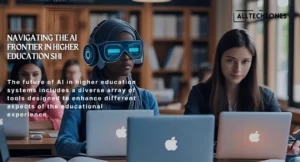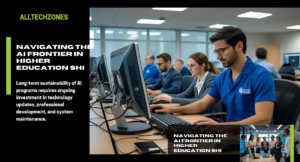The landscape of higher education is undergoing a revolutionary transformation as artificial intelligence (AI) technologies reshape how students learn, educators teach, and institutions operate. Navigating the AI frontier in higher education SHI represents more than just technological adoption—it signifies a fundamental shift toward intelligent, personalized, and efficient educational ecosystems that prepare students for an AI-driven future.
As educational institutions worldwide grapple with evolving student needs, budget constraints, and the demand for innovative learning solutions, AI emerges as a powerful catalyst for change. From personalized learning pathways to automated administrative processes, AI in education is creating unprecedented opportunities to enhance educational outcomes while addressing long-standing challenges in academic environments.
This comprehensive exploration examines how SHI’s approach to AI integration in education is pioneering new standards for academic excellence, the transformative potential of AI tools in university settings, and the critical considerations institutions must address when implementing intelligent technologies in their educational frameworks.
Understanding AI’s Revolutionary Impact on Higher Education
Artificial intelligence in higher education extends far beyond simple automation or digital tools. It represents a paradigmatic shift toward data-driven decision-making, personalized learning experiences, and intelligent systems that adapt to individual student needs while supporting faculty in delivering more effective instruction.
The integration of AI technologies in academic environments encompasses various applications, from natural language processing systems that provide instant student support to machine learning algorithms that analyze learning patterns and predict student success rates. These technologies are fundamentally changing how educational content is delivered, consumed, and evaluated.
Modern AI systems in higher education can process vast amounts of student data to identify learning gaps, recommend personalized study materials, and even predict which students might need additional support before they begin struggling academically. This proactive approach to education represents a significant departure from traditional reactive teaching methods.
Educational institutions implementing AI solutions report improved student engagement rates, enhanced learning outcomes, and more efficient administrative operations. The technology enables educators to focus on high-value activities like mentoring and creative instruction while AI handles routine tasks such as grading, scheduling, and basic student inquiries.
SHI’s Strategic Approach to AI Integration in Education
SHI’s methodology for navigating artificial intelligence in higher education emphasizes a balanced integration that prioritizes educational value while maintaining ethical standards and faculty autonomy. This approach recognizes that successful AI implementation requires careful planning, comprehensive training, and ongoing evaluation to ensure technologies enhance rather than replace human expertise.
The SHI framework for AI adoption focuses on identifying specific educational challenges that AI can address effectively while preserving the essential human elements of education. This includes maintaining meaningful student-faculty interactions, supporting collaborative learning environments, and ensuring that technology serves pedagogical goals rather than driving them.
Implementation strategies within the SHI model emphasize gradual integration, allowing faculty and students to adapt to new technologies while maintaining knowledge quality. This approach includes comprehensive training programs for educators, clear guidelines for AI use in academic settings, and robust support systems to address technical and pedagogical challenges.
The SHI approach also prioritizes transparency in AI implementation, ensuring that students and faculty understand how AI systems work, what data they collect, and how that information is used to enhance educational experiences. This transparency builds trust and encourages more effective utilization of AI tools across the institution.
Transformative AI Tools Reshaping University Classrooms
The future of AI in higher education systems includes a diverse array of tools designed to enhance different aspects of the educational experience. Intelligent tutoring systems provide personalized instruction that adapts to individual learning styles and paces, offering students additional support outside traditional classroom hours.

AI-powered assessment tools are revolutionizing how educators evaluate student performance, providing detailed analytics on learning progress and identifying areas where students need additional support. These systems can analyze written work for clarity, coherence, and critical thinking while providing constructive feedback that helps students improve their academic skills.
Virtual teaching assistants powered by AI are becoming increasingly sophisticated, capable of answering student questions, providing course information, and even facilitating basic discussions about course material. These systems operate 24/7, ensuring students have access to support whenever they need it.
Content creation and curation tools use AI to help educators develop engaging learning materials, suggest relevant resources, and adapt existing content for different learning styles. These tools significantly reduce the time educators spend on content preparation while improving the quality and relevance of edu materials.
Predictive analytics systems analyze student behavior patterns, attendance records, and academic performance to identify students at risk of academic failure or dropout. This early warning system enables institutions to provide timely interventions and support services.
Personalizing Student Learning Through AI Innovation
Using AI to personalize student learning at SHI involves creating adaptive learning environments that respond to individual student needs, preferences, and learning patterns. This personalization extends beyond simple content recommendations to encompass comprehensive learning pathway optimization.
AI systems analyze how individual students interact with course materials, identifying optimal learning sequences, preferred content formats, and effective study strategies. This information enables the creation of customized learning experiences that maximize individual student potential while maintaining course objectives and standards.
Adaptive learning platforms adjust content difficulty, pacing, and presentation style based on real-time student performance data. Students who grasp concepts quickly receive more challenging material, while those who need additional support receive supplementary resources and alternative explanations.
Personalized feedback systems provide students with detailed insights into their learning progress, highlighting strengths and identifying areas for improvement. This feedback is tailored to individual learning styles and includes specific recommendations for enhancing academic performance.
AI-driven scheduling systems help students optimize their study time by analyzing their learning patterns, course requirements, and personal schedules to create efficient study plans that maximize learning outcomes while accommodating individual constraints and preferences.
For more Tech related blogs keep visiting Alltechzones.
The Evolving Role of Faculty in AI-Enhanced Education
The role of faculty in AI-driven classrooms is evolving from traditional information delivery to more complex functions including learning facilitation, critical thinking development, and AI system oversight. This transformation requires educators to develop new skills while leveraging their expertise in human development and subject matter mastery.
Faculty members are becoming learning architects, designing educational experiences that effectively integrate AI tools while maintaining the human connections essential to meaningful education. This role requires understanding both pedagogical principles and AI capabilities to create optimal learning environments.
Educators are also taking on roles as AI literacy instructors, helping students develop critical skills for working with AI systems, understanding their limitations, and using them ethically. This includes teaching students to evaluate AI-generated content, understand algorithmic bias, and maintain academic integrity when using AI tools.
The supervisory function of faculty in AI-enhanced environments involves monitoring AI system performance, ensuring educational quality, and making adjustments when technology fails to meet pedagogical objectives. This oversight ensures that AI serves educational goals rather than replacing human judgment in educational decisions.
Faculty collaboration with AI systems creates opportunities for enhanced research capabilities, improved course design, and more effective student mentoring. This partnership model leverages the strengths of both human expertise and artificial intelligence to create superior edu outcomes.
Addressing Ethical Considerations in AI-Enhanced Learning
Ethical concerns of AI in academic environments encompass privacy protection, algorithmic fairness, academic integrity, and the digital divide. Institutions must develop comprehensive policies that address these concerns while maximizing the benefits of AI technologies.

Data privacy represents a critical consideration as AI systems collect and analyze vast amounts of student information. Institutions must implement robust data protection measures, ensure transparent data use policies, and provide students with control over their personal information.
Algorithmic bias in AI systems can perpetuate or amplify existing educational inequities. Institutions must regularly audit AI systems for bias, ensure diverse representation in AI development teams, and implement corrective measures when bias is detected.
Academic integrity challenges arise as AI tools become more sophisticated and accessible to students. Educational institutions must develop clear policies regarding AI use in academic work, provide guidance on appropriate AI utilization, and implement detection systems for inappropriate AI use.
The digital divide poses significant challenges as AI implementation may advantage students with better technology access while disadvantaging those without adequate resources. Institutions must ensure equitable access to AI tools and provide support for students who may lack necessary technical skills or equipment.
Implementing AI Solutions: Practical Strategies for Success
Successful AI implementation in higher education requires systematic planning, stakeholder engagement, and ongoing evaluation. Institutions must develop clear implementation strategies that address technical, pedagogical, and organizational challenges.
Infrastructure development forms the foundation of successful AI implementation, requiring robust network capabilities, adequate computing resources, and reliable technical support systems. Institutions must invest in technological infrastructure while ensuring systems can scale to meet growing demands.
Professional development programs for faculty and staff are essential for successful AI adoption. These programs should cover both technical skills and pedagogical applications, helping educators understand how to effectively integrate AI tools into their teaching practices.
Pilot programs allow institutions to test AI solutions in controlled environments before full-scale implementation. These programs provide valuable insights into system performance, user acceptance, and potential challenges while minimizing risks and costs.
Change management strategies help institutions navigate the cultural and organizational shifts required for successful AI adoption. This includes communicating benefits clearly, addressing concerns proactively, and providing ongoing support throughout the transition process.
For more Tech related blogs keep visiting Alltechzones.
Measuring Success: Evaluating AI Impact on Educational Outcomes
How AI is changing higher education at SHI can be measured through various metrics including student performance improvements, engagement levels, retention rates, and faculty satisfaction scores. Comprehensive evaluation systems help institutions understand AI’s impact and make necessary adjustments.
Learning analytics provide detailed insights into student progress, identifying patterns that indicate effective AI utilization and areas where improvements are needed. These analytics help institutions optimize AI implementations for maximum educational benefit.
Student satisfaction surveys and feedback systems provide valuable insights into user experiences with AI tools. This feedback helps institutions identify successful implementations and address concerns that may hinder effective AI utilization.
Faculty performance metrics examine how AI tools affect teaching effectiveness, course delivery, and student outcomes. These assessments help institutions understand the impact of AI on educational quality and make necessary adjustments to support faculty success.
Cost-benefit analyses evaluate the financial impact of AI implementations, comparing implementation costs with benefits such as improved efficiency, enhanced outcomes, and reduced operational expenses. These analyses help institutions make informed decisions about AI investments.
Future Trends and Emerging Technologies
The future of AI-powered learning includes emerging technologies such as augmented reality integration, advanced natural language processing, and sophisticated predictive modeling systems. These technologies will further enhance personalized learning experiences and create new opportunities for educational innovation.
Quantum computing applications in education may revolutionize complex problem-solving capabilities and enable more sophisticated AI systems that can process vast amounts of educational data in real-time. These capabilities will support more precise personalization and predictive analytics.
Blockchain technology integration with AI systems may provide enhanced data security, credentialing verification, and transparent tracking of educational achievements. This combination could create more secure and verifiable educational records while maintaining privacy protections.
Internet of Things (IoT) integration with AI systems will create smart campus environments that respond to student needs, optimize resource utilization, and provide comprehensive data for educational improvement. These systems will support more efficient and effective educational delivery.
Advanced emotional AI capabilities will enable systems to recognize and respond to student emotional states, providing appropriate support and adjusting learning experiences to maintain optimal engagement and motivation levels.
Building Sustainable AI Programs in Higher Education
Long-term sustainability of AI programs requires ongoing investment in technology updates, professional development, and system maintenance. Institutions must develop sustainable funding models that support continuous AI evolution and improvement.

Partnership strategies with technology companies, other educational institutions, and research organizations can provide access to cutting-edge AI technologies while sharing implementation costs and expertise. These partnerships create opportunities for collaborative innovation and resource sharing.
Talent development programs help institutions build internal AI expertise, reducing dependence on external vendors while creating career advancement opportunities for faculty and staff. These programs ensure institutions can maintain and evolve their AI systems effectively.
Continuous improvement processes enable institutions to adapt AI implementations based on changing needs, emerging technologies, and evolving best practices. These processes ensure AI systems remain effective and relevant over time.
Risk management strategies address potential challenges such as technology failures, cybersecurity threats, and regulatory changes. Comprehensive risk management ensures AI programs can continue operating effectively despite potential disruptions.
For more Tech related blogs keep visiting Alltechzones.
FAQs About navigating the ai frontier in higher education shi
1. What are the primary benefits of implementing AI in higher education?
AI implementation in higher education offers numerous benefits including personalized learning experiences, improved student outcomes, enhanced faculty efficiency, predictive analytics for student success, automated administrative processes, and 24/7 student support through AI-powered systems.
2. How does SHI’s approach to AI integration differ from other educational technology implementations?
SHI’s approach emphasizes balanced integration that prioritizes educational value while maintaining ethical standards and faculty autonomy. This methodology focuses on gradual implementation, comprehensive training, transparency, and ensuring AI enhances rather than replaces human expertise in education.
3. What challenges do institutions face when implementing AI in higher education?
Common challenges include infrastructure requirements, faculty training needs, data privacy concerns, ethical considerations, cost of implementation, resistance to change, ensuring equitable access, and maintaining academic integrity while using AI tools effectively.
4. How can AI tools personalize learning for individual students?
AI personalizes learning by analyzing individual student behavior patterns, learning preferences, and performance data to create customized learning pathways, adjust content difficulty, provide targeted feedback, recommend relevant resources, and optimize study schedules based on personal learning patterns.
5. What role do faculty members play in AI-enhanced classrooms?
Faculty roles evolve to include learning facilitation, AI system oversight, critical thinking development, AI literacy instruction, and maintaining human connections in education. Educators become learning architects who design experiences integrating AI tools while preserving essential human elements.
6. How do institutions address ethical concerns related to AI in education?
Institutions address ethical concerns through comprehensive data privacy policies, regular algorithmic bias audits, clear academic integrity guidelines, transparent AI use policies, equitable access provisions, and ongoing monitoring of AI system performance and impact.
7. What metrics should institutions use to measure AI implementation success?
Success metrics include student performance improvements, engagement levels, retention rates, faculty satisfaction scores, learning analytics insights, cost-benefit ratios, user feedback, and long-term educational outcome assessments.
8. How can institutions ensure sustainable AI programs in higher education?
Sustainability requires ongoing investment in technology updates, professional development, strategic partnerships, internal talent development, continuous improvement processes, comprehensive risk management, and sustainable funding models that support long-term AI evolution.
9. What emerging AI technologies will impact higher education in the future?
Emerging technologies include advanced natural language processing, augmented reality integration, quantum computing applications, blockchain integration for credentialing, IoT-enabled smart campuses, and sophisticated emotional AI systems that respond to student emotional states.
10. How can institutions prepare faculty for AI integration in their teaching practices?
Preparation involves comprehensive professional development programs covering both technical skills and pedagogical applications, hands-on training with AI tools, ongoing support systems, collaborative learning opportunities, and resources for understanding AI’s educational potential and limitations.
Conclusion
Navigating the AI frontier in higher education SHI represents a transformative opportunity to enhance educational quality, improve student outcomes, and create more efficient institutional operations. Success requires thoughtful implementation strategies that balance technological innovation with educational values and ethical considerations.
The integration of AI in higher education is not merely about adopting new technologies but about reimagining educational possibilities and creating learning environments that prepare students for an AI-enhanced future. Institutions that embrace this transformation thoughtfully and strategically will be best positioned to provide exceptional educational experiences while maintaining the human connections that make education meaningful.
As AI technologies continue to evolve, educational institutions must remain adaptable, ethical, and focused on their core mission of developing human potential. The future of AI-powered learning depends on maintaining this balance while leveraging technology’s capabilities to create educational experiences that are more personalized, effective, and accessible than ever before.
Disclaimer: This content is provided for informational and educational purposes only. While every effort has been made to ensure accuracy, the rapidly evolving nature of AI technology means that specific implementations, capabilities, and best practices may change over time. Institutions considering AI implementation should conduct thorough research, consult with technology experts, and develop policies appropriate to their specific contexts and needs. This article does not constitute professional advice for technology procurement or educational policy decisions.
For more Tech related blogs keep visiting Alltechzones.
